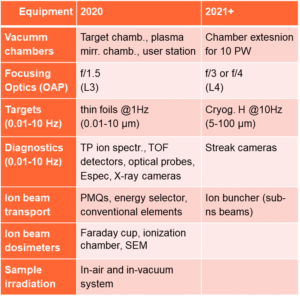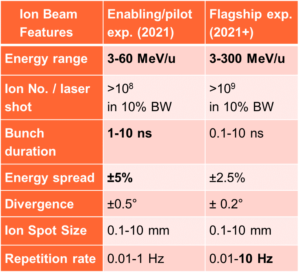Thus, the optimization of particle beam quality and reproducibility (spatial profile, pointing, divergence and energy stability) is a priority of the Department scientific agenda, trying to fulfill the expectations of the scientific user community which are summarized in ELI white book.
Laser-driven particle acceleration is a novel field of physics that is rapidly evolving thanks to the continuing development of high power laser systems, thus allowing researchers to investigate the interaction of relativistic laser intensities (> 1019 W/cm2) with matter. As a result of such interaction, extremely high electric and magnetic fields are generated. Such tremendous fields, which can be supported only in a plasma, allow for the acceleration of particles by way of very compact approaches. In particular, spectacular progress in the acceleration of protons through energy transfer from relativistic electrons in thin solid targets has been achieved, currently leading to record proton energies around 100-MeV [Higginson et al].
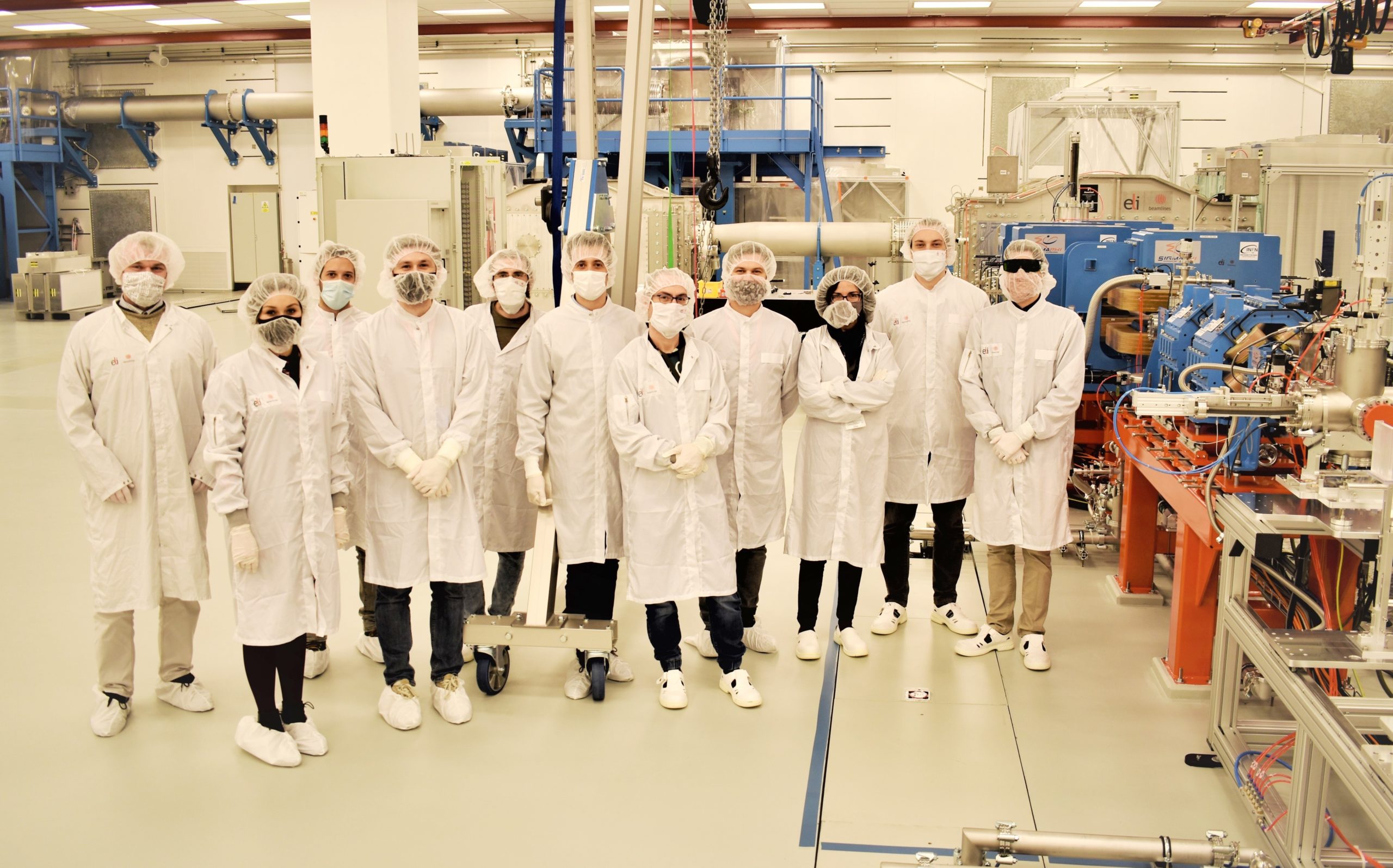
A photo of the Ion Acceleration and Applications of High Energy Particles team in charge of the ELIMAIA ion beamline user operations
LASER-PLASMA ION ACCELERATION
According to the state of the art in laser-driven ion acceleration, maximum proton energies approaching the 100-MeV level have been experimentally achieved with a relatively high yield (1010-1012 protons/pulse) [Macchi et al, Higginson et al]. However, laser-accelerated ion beams are still not mature for several applications in which additional features, such as low divergence, narrow energy spread, spatial profile uniformity, or shot-to-shot stability, are essential. Nevertheless, new laser technologies that will soon be available, e.g. at ELI Beamlines, will allow the scientific community to investigate novel plasma acceleration regimes that are very promising in terms of future use of laser-driven ion beams for multidisciplinary applications.
In general, such high energy ion beams are produced in thin solid targets by a strong electric field, which is, in turn, generated by a collective displacement of a large number of electrons. Such fields accelerate ions until charge neutrality is restored and they move together with electrons in a ballistic way. Until now, most of the experiments on laser-driven proton acceleration have been performed in a regime known as Target Normal Sheath Acceleration (TNSA). This scheme is based on the space-charge field generated at the rear surface of a micrometer-thick target. Such a quasi-electrostatic field is generated by high energy electrons, also known as “hot electrons”, which are accelerated by a high intensity laser at the target front surface, then cross the target bulk and attempt to escape in a vacuum from the rear side (see figure below). Currently, thanks to higher laser intensities achievable with newly installed laser systems, along with the use of thinner and specially engineered targets, new acceleration mechanisms are emerging. Protons can be consequently accelerated not only by longitudinal electric fields (established because of space charge separation), but also by laser radiation pressure, plasma shock waves and relativistic-induced transparency acceleration mechanisms [Macchi et al].

Schematic representation of the TNSA mechanism for ion acceleration (side view) [Roth & Schollmeier]
2D Particle-in-cell simulation showing the result of the interaction between a high-intensity laser pulse (parameters are relevant to L3-HAPLS laser and thus to ELIMAIA beamline) and a micrometer-thick plastic target. Acceleration of both protons (pink color) and carbon ions (green color) to a maximum energy of 150 MeV and 40 MeV/nucleon, respectively, is highlighted through the color bars.
Multidisciplinary applications of laser-driven ions
Currently, the scenarios of laser driven acceleration as well as particle handling systems are being improved in order to fulfill requirements of foreseen applications with strong socioeconomic impact e.g. cancer treatment (laser-driven hadrontherapy), fast ignition of inertial confinement fusion (ICF) targets, laser triggering and control of nuclear reactions, material science, non-destructive heritage testing, chemistry etc. [Macchi et al, al]. The main direction proposed by the community of experts in this field is to improve the laser-accelerated ion features (maximum energy and energy spread, charge, emittance, shot-to-shot stability, etc.) in order to propose reliable and very compact approaches to be used for societal applications, thus reducing the overall cost of standard large-size acceleration facilities. The main goal of the ion beamline being commissioned at ELI Beamlines, ELIMAIA (ELI Multidisciplinary Applications of laser-Ion Acceleration) [], is to provide well-characterized, highly stable and tunable beams of particles accelerated by PW-class lasers to be offered to the user community for multidisciplinary applications. Medical applications are clearly the most attractive among those envisioned, since they might have a strong, positive impact on society. In particular, a potential use of laser-based hadrontherapy facilities is currently under investigation at the international level, as demonstrated by the ELIMED (ELI MEDical applications) network. The ELIMAIA beamline will allow users to investigate multidisciplinary applications using laser driven ion beams, such as in-vitro radiation biology and pre-clinical studies within the ELIMED international cooperation.
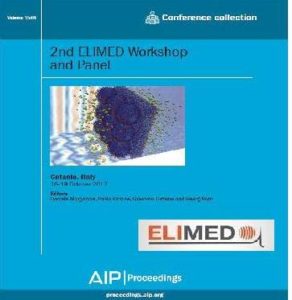
The ELIMED international network
Experimental target areas
The ELIMAIA user beamline in E4
ELIMAIA (ELI Multidisciplinary Applications of laser-Ion Acceleration) will be one of the key secondary source based beamlines of the ELI Beamlines user facility. The technological solutions available at the ELIMAIA beamline are the result of a complex investigation carried out in the last several years with the main goal of fulfilling the specific requirements that have been coming from the international multidisciplinary user community.
The general approach for the design, development, and implementation of the ELIMAIA beamline was based on three key features: user-friendly technology implementation, accurate monitoring and reliability of the accelerated ion beams, and flexibility for future upgrades. A complex beamline (ion source, in-vacuum ion beam transport, various dosimetry endpoints, and in-air sample irradiation end-station) is available for users to enable them to apply laser-driven ion beams in multidisciplinary fields.
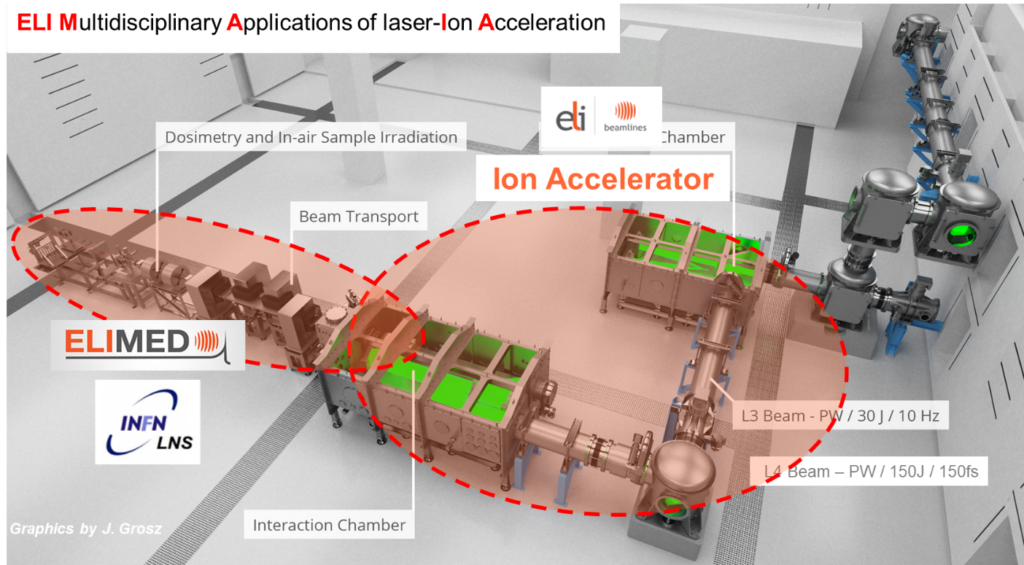
A 3D rendering of the ELIMAIA beamline is shown in the figure above. ELIMAIA is located in the northern part of experimental hall 4 (E4). The available laser beams are L3 and L4 (both at 1 PW peak power level) entering E4 from its western wall. The ELIMAIA beamline consists of two main subsystems: Ion Accelerator and ELIMED. A street view of the E4 experimental target area is available here:
The first subsystem is represented by a double plasma mirror chamber and main interaction chamber. The plasma mirror system allows to clean the laser beam from sub-nanosecond pre-pulses. The beam then continues its propagation into the interaction chamber through a laser diagnostic section where various laser parameters, such as energy, pulse duration and wavefront, are measured. After a proper control of their properties, the laser beams are focused onto the target by off-axis parabolic mirrors. The main proton/ion beam produced at the laser-target interaction point propagates from west to east and is sent into the ELIMED subsystem, which is represented by the in-vacuum ion beam transport and diagnostics, and by the in-air ion beam dosimetry and sample-irradiation sections. The accelerated ions are collected by a set of permanent magnet quadrupoles to be used for a preliminary focalization and for a rough energy selection of the laser-driven ion beams. The beam transport line accommodates various diagnostic systems (high energy Thomson Parabola spectrometer, detector arrays for beam emittance measurements, time-of-flight detectors). The accelerated proton/ion beam is shaped in space and in energy according to the specific request coming from the user. A set of quadrupole magnets, focusing the accelerated particle beam (typically having a high angular divergence), and an energy selector system, selecting the required energy window, is used to address this issue. The particle beam then enters the in-air ion beam dosimetry section where its properties are measured at different positions and further shaped, depending on the specific user application. Therefore, the dose released to the final sample (e.g., a radiobiological one) is monitored with relative and absolute dosimetry systems, ad-hoc developed for ultrahigh dose rate ion bunches, allowing real-time control of the delivered particle beam. A detailed description of the various technologies available at the ELIMAIA beamline can be found in . The expected ion beam features, along with key equipment available at ELIMAIA, are summarized in the tables below.
Most of the building services in E4 are provided through hubs with unified connection panels. The building services provide HVAC and lights as well as several distributed utilities for specific usage, such as primary vacuum (backing and roughing separate lines), de-mineralized cooling water, compressed, clean, dry air, gaseous nitrogen at room temperature, communication networks, drainage, and exhalation exhaust.
The Teresa Target Area in L2
The teresa target area in l2
TERESA (TEstbed for high REpetition-rate Sources of Accelerated particles) is a laser–plasma experimental area that has been recently commissioned at ELI Beamlines. Its main purpose is developing and testing of novel solutions for target delivery and laser–plasma diagnostics at high repetition rate (up to 10 Hz). TERESA uses a circular sub-aperture of the L3-HAPLS laser, the full power of which (1 PW) will be available to users at the other target areas currently being commissioned.
Additional operation scenarios of the TERESA target area include: optimization of plasma source parameters (via target choice and fine-tuning of the laser features on target); study of laser–plasma interaction with over-critical and sub-critical density targets (pre-plasma expansion, laser absorption, transmission and back-reflection, plasma self-emission, etc.); ion irradiation of secondary targets of interest (user samples) for ultrahigh dose rate radiobiology, cultural heritage and nuclear physics; functional tests of user equipment with the L3-HAPLS laser at the Joule level and at high repetition rate, prior to its installation in the experimental beamlines/platforms where L3-HAPLS will be mainly used at PW-level.
The TERESA target area is located inside the L2 laser hall at the ELI Beamlines laser floor, which is right next to the L3 laser hall. This location is advantageous due to a short beam path and a simple vacuum connection to the L3 compressor output. TERESA is designed to perform experiments at high vacuum (~10^-6 mbar). Its vacuum system consists of four interconnected chambers. The first two mainly serve the purpose of laser beam transport, while the next two accommodate focusing optics, laser-target interaction and various diagnostics. A detailed description of the TERESA target area containing information about laser parameters, beam transport, control and vacuum systems, along with available laser-plasma diagnostics and target systems is available here [Tryus et al].
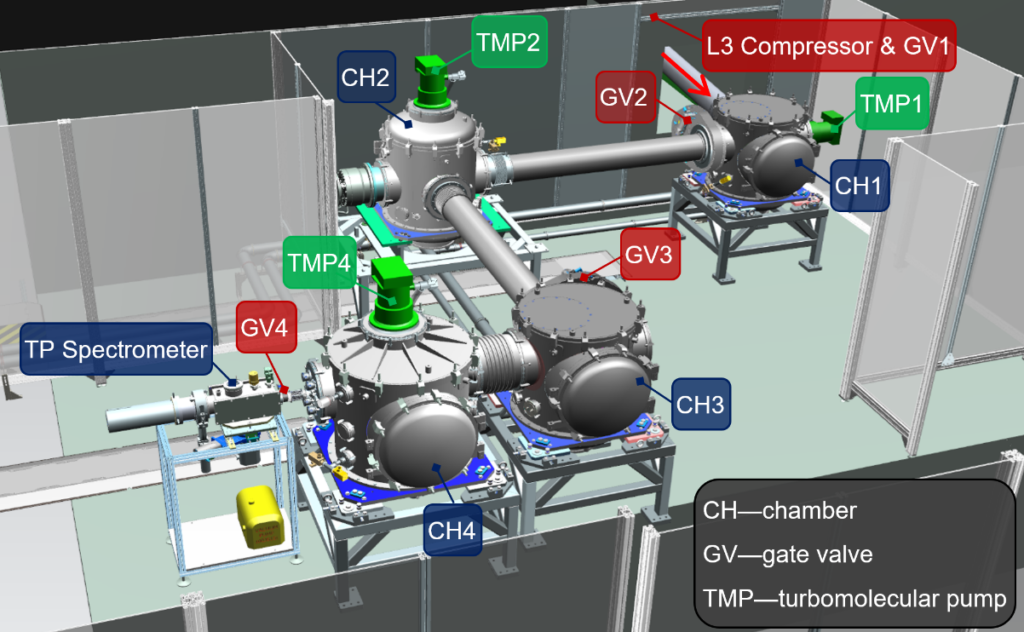
R&D Activities
Various Research & Development activities are carried out within the Department of Ion Acceleration and Applications of High Energy Particles thanks to research grants currently running, and to cooperation with national and international partners both from the public and from the private sector. A brief summary of such activities is provided below.
ELIMED and laser driven hadrontherapy
The main goal of the ELIMAIA beamline is to provide stable, fully characterized, and tunable particle beams accelerated by PW-class lasers and to offer them to a broad national and international community of users for multidisciplinary applications, as well as fundamental science. However, a strong interest in future clinical applications of laser-driven ions for hadrontherapy has been demonstrated by users, thus an international scientific network, called ELIMED (ELI MEDical applications) has been established ELIMED workshop and Panel proceeding. However, this is only one of the potential applications of the ELIMAIA beamline, which will be open to several proposals from a multidisciplinary user community. These proposals will be for areas such as non-conventional ion acceleration, radiobiology, time-resolved radiography of different materials, and beam-target nuclear reactions generating isotopes for positron emission tomography or producing high brilliance secondary radiation sources (e.g., neutrons and alpha-particles).
Proton-boron nuclear fusion and applications
The conventional route to nuclear fusion for power generation is based on the reaction between deuterium and tritium nuclei, which yields one alpha particle and one neutron.
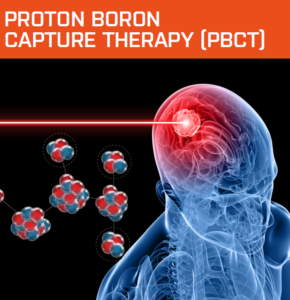 Formidable technology challenges, however, stem from the production and handling of tritium as well as from the radiation damage and radioactivity induced by the high-energy neutron in reactor materials. In this respect, the fusion reaction between a proton and a boron-11 nucleus to yield three alpha particles is very attractive as it involves only abundant and stable isotopes in the reactants, and no neutron in the reaction products.
Formidable technology challenges, however, stem from the production and handling of tritium as well as from the radiation damage and radioactivity induced by the high-energy neutron in reactor materials. In this respect, the fusion reaction between a proton and a boron-11 nucleus to yield three alpha particles is very attractive as it involves only abundant and stable isotopes in the reactants, and no neutron in the reaction products.
Unfortunately, the hydrogen-boron plasma has an ignition temperature that is ten times higher than the deuterium-tritium one, thus proton-boron fusion is prohibitive to exploit under thermonuclear schemes.
Nevertheless, in the last 15 years proton-boron fusion has effectively been induced by means of high-power lasers (Patent CZ2013596: Nuclear fusion fixed target, device to generate nuclear fusion and method of generating nuclear fusion), showing an impressive progression in the reaction yield. Recent experimental findings and theoretical predictions [L. Giuffrida et al.], along with the advent of dramatically enhanced laser capabilities, call for an urgent, systematic investigation of possible ignition schemes in laser-driven proton-boron fusion.
Recently, an innovative technique named PBCT (Proton Boron Capture Therapy) has been demonstrated experimentally using molecules containing 11B nuclei absorbed in cancer cells (in-vitro tests) which can potentially be administered onto a deep-seated tumor and then bombarded with a proton beam typically used in hadrontherapy [G.A.P. Cirrone et al., Patent EP3266470: Device and method for imaging and enhanced proton-therapy treatment using nuclear reactions]. As a consequence of the interaction of the proton beam with 11B nuclei, alpha-particles with low energy (around 4 MeV) are generated in the nuclear fusion events and ultimately stopped inside the tumor, thus releasing their entire energy in a single cancer cell. The macroscopic effect is an enhanced biological damage of the tumor and treatment selectivity (with a simultaneously reduction of unwanted side effects on healthy tissues) compared to that caused only by the incoming protons.
This topic is currently being investigated by the Department of Ion Acceleration and Applications of High Energy Particles in cooperation with our international partner, LNS-INFN (Istituto Nazionale di Fisica Nucleare-Italy) and supported by the Technology Agency of the Czech Republic, TACR (GAMA2 project TP01010035: Proton Boron Capture Therapy (PBCT): in-vivo validation for clinical application) and by INFN and Italian Ministry of Education (NEPTUNE: Nuclear process driven Enhancement of Proton Therapy UNravEled and PBCT PRIN-MIUR projects, respectively).
Non-destructive heritage testing
Non-invasive and non-destructive techniques using laser-accelerated protons for testing and protecting cultural heritage enable accurate documentation and verification of ancient and historical artifacts. Their use serves to prove originality, detect forgeries, and provide information about the original materials and artistic techniques used. Such information is relevant for provenance studies and indirect dating.
The Department of Ion Acceleration and Applications of High Energy Particles at ELI Beamlines is developing innovative technological solutions based on Proton Induced X-ray Emission (PIXE) and Deep Proton Activation Analysis (DPAA) with the main goal to test cultural heritage items, taking advantage of both compactness and flexibility of a laser-plasma proton accelerator. These two methods can be combined to obtain key information about the elemental composition both of the surface and deep layers of the investigated item (e.g. behind the corrosion layer).
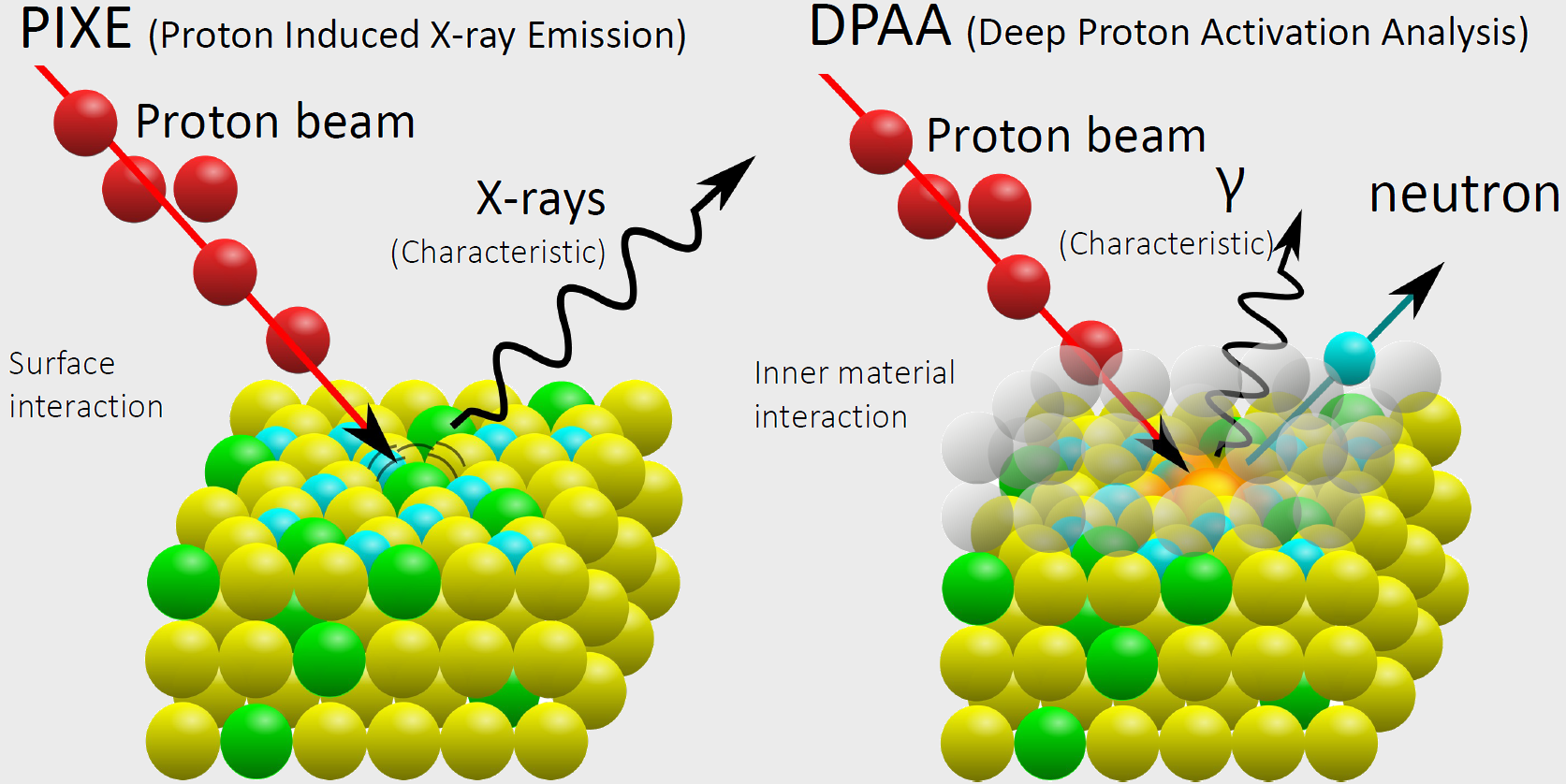
Schematic principle of PIXE and of DPAA techniques, [part of the image taken from Institute of Physics, University of Sao Paulo websites]
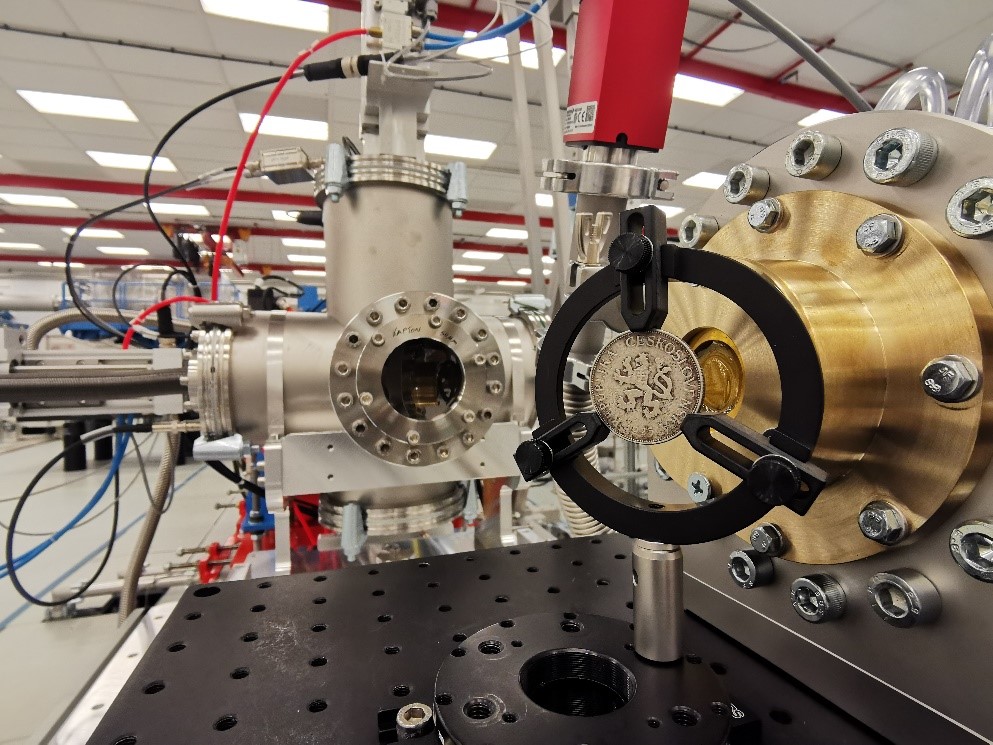 Laser-based PIXE and DPAA are implemented to recognize the elemental
Laser-based PIXE and DPAA are implemented to recognize the elemental
composition of the investigated item, ranging from sodium to uranium, even with low ppm concentrations and in a selective way for different layers of the object. These methods are suitable for (but not limited to) painted and glazed ceramics, statues, glass, jewelry, paintings, inks, and icons. These technologies do not require in-vacuum measurements, thus there is no risk of degradation caused by outgassing or dehydration of the tested items, and no limitation due to the dimensions or shape of the samples to be investigated. While the methods are intended for heritage testing primarily, laser-based PIXE can also be used for studying aerosols in environmental science, biological samples, or trace elements for forensic purposes and quality control in industries. In fact, it is highly expected that the heritage end-station will be extended to other material investigation techniques in the future.
Cooperation with research institutes and industry
Laser-driven ion sources have a great potential both in fundamental science and in a wide range of foreseen applications. The Department of Ion Acceleration and Applications of High Energy Particles at ELI Beamlines cooperates on various projects with the following public and private partners:
- Istituto Nazionale di Fisica Nucleare – Laboratori Nazionali del Sud (NFN-LNS), Catania, Italy
- Centre for Plasma Physics, Queen’s University Belfast, UK
- The Center for Intense Lasers and Applications (CELIA), Bordeaux, France
- CEA Grenoble Center, France
- FBK, Trento, Italy
- The National Institute of Optics (Istituto Nazionale di Ottica, CNR-INO), Pisa, Italy
- The Institute of Plasma Physics and Laser Microfusion in Warsaw (IPPLM), Poland
- University of Strathclyde, Glasgow, UK
- Czech Technical University in Prague (CTU), Czech Republic
– Faculty of Nuclear Sciences and Physical Engineering, CTU
- Charles University, Prague, Czech Republic
- Marvel Fusion, Munich, Germany
- The City of Prague Museum (Muzeum hl. Města Prahy), Czech Republic
- Institute of Archaeology of the Czech Academy of Sciences (Archeologický ústav AV ČR), Czech Republic
- Institute of Laser Engineering (ILE), Osaka University, Japan
Workshop and conferences
Oncoming:
Unfortunately, there are no announced conferences or workshops at this moment.
If you wish to be regularly contacted about our upcoming events, please send us your email to: info@eli-beams.eu
Past:
ELIMED II 2012
ELIMED III 2016
ELIMAIA user workshop 2019
Elimaia user workshops 2020
pB fusion workshop 2020
Selected research outputs
Ion acceleration
- Margarone, O. Klimo, IJ Kim et al. Laser-Driven Proton Acceleration Enhancement by Nanostructured Foils. Physical Review Letters 2012, 109. https://journals.aps.org/prl/abstract/10.1103/PhysRevLett.109.234801
- Margarone et al. Proton Acceleration Driven by a Nanosecond Laser from a Cryogenic Thin Solid- Hydrogen Ribbon. Physical Review X 6, 041030 (2016). https://journals.aps.org/prx/abstract/10.1103/PhysRevX.6.041030
- Giuffrida et al., Manipulation of laser-accelerated proton beam profiles by nanostructured and microstructured targets, Physical Review. Accelerators and Beams 20, 081301 (2017).https://journals.aps.org/prab/abstract/10.1103/PhysRevAccelBeams.20.081301
- Psikal & M. Matys, Dominance of hole-boring radiation pressure acceleration regime with thin ribbon of ionized solid hydrogen. Plasma Physics and Controlled Fusion 60, 044003 (2018). https://iopscience.iop.org/article/10.1088/1361-6587/aaa7fa/pdf
- Levato et al., Laser-plasma accelerated protons: energy increase in gas-mixtures using high mass number atomic species. Fluids 4.3 (2019): 150. https://www.mdpi.com/2311-5521/4/3/150
Beamlines and Target Areas
- Margarone et al. ELIMAIA: A Laser-Driven Ion Accelerator for Multidisciplinary Applications. Quantum Beam Sci. 2018, 2, 8. https://www.mdpi.com/2412-382X/2/2/8
- Tryus et al. TERESA Target Area at ELI Beamlines. Quantum Beam Sci. 2020, 4(4), 37. https://www.mdpi.com/2412-382X/4/4/37
- A.P. Cirrone et al., ELIMED-ELIMAIA: The First Open User Irradiation Beamline for Laser-Plasma-Accelerated Ion Beams. Front. Phys. 8, 437 (2020)https://www.frontiersin.org/article/10.3389/fphy.2020.564907
Diagnostics and beam transport
- Margarone et al., Full characterization of laser-accelerated ion beams using Faraday cup, silicon carbide, and single-crystal diamond detectors J. Appl. Phys. 109, 103302 (2011). https://aip.scitation.org/doi/10.1063/1.3585871
- Scuderi et al., TOF diagnosis of laser accelerated, high-energy protons. Nuclear Inst. and Methods in Physics Research, A 978 (2020) 164364. https://www.sciencedirect.com/science/article/pii/S0168900220307610?via%3Dihub
- Scuderi et al., Diagnostics and Dosimetry Solutions for Multidisciplinary Applications at the ELIMAIA Beamline. Appl. Sci. 2018, 8, 1415. https://www.mdpi.com/2076-3417/8/9/1415
- Milluzzo et al., A new energy spectrum reconstruction method for time-of-flight diagnostics of high-energy laser-driven protons. Review of Scientific Instruments 90.8 (2019): 083303. https://aip.scitation.org/doi/full/10.1063/1.5082746?casa_token=o6WVZsro9AUAAAAA%3AMZfxDd0cw8VMt-HQENFBZiZod74oeK1w2WXBzrcejJKxXM_nFvMsnurlM_gGMdGeijCnlTmuxrBI
- Scuderi et al., TOF diagnosis of laser accelerated, high-energy protons. Nuclear Instruments and Methods in Physics Research Section A: Accelerators, Spectrometers, Detectors and Associated Equipment 978 (2020): 164364. https://www.sciencedirect.com/science/article/pii/S0168900220307610
- Schillaci et al., Design of the ELIMAIA ion collection system. Journal of Instrumentation 10.12 (2015): T12001. https://iopscience.iop.org/article/10.1088/1748-0221/10/12/T12001/
- Schillaci et al., Design of a large acceptance, high efficiency energy selection system for the ELIMAIA beam-line. Journal of Instrumentation, 11(08), P08022 (2016). https://iopscience.iop.org/article/10.1088/1748-0221/11/08/P08022/pdf
Proton-Boron nuclear reaction:
- Picciotto et al., Boron-Proton Nuclear-Fusion Enhancement Induced in Boron-Doped Silicon Targets by Low-Contrast Pulsed Laser, Phys. Rev. X 4, 031030 (2014). https://journals.aps.org/prx/abstract/10.1103/PhysRevX.4.031030
- Margarone et al., Advanced scheme for high-yield laser driven nuclear reactions, Control. Fusion 57, 014030 (2015). https://iopscience.iop.org/article/10.1088/0741-3335/57/1/014030
- Giuffrida et al., High current stream of energetic alpha particles from laser driven proton-boron fusion` by Physical Review E 101, 013204 (2020). https://journals.aps.org/pre/abstract/10.1103/PhysRevE.101.013204
- Margarone et al., Generation of α-Particle Beams With a Multi-kJ, Peta-Watt Class Laser System. Front. Phys., 09 September 2020.
- https://www.frontiersin.org/articles/10.3389/fphy.2020.00343/full
- First experimental proof of Proton Boron Capture Therapy (PBCT) to enhance protontherapy effectiveness` by G. A. P. Cirrone et al., Scientific Reports 8, 1141 (2018). https://www.nature.com/articles/s41598-018-19258-5
- Prompt gamma ray diagnostics and enhanced hadron-therapy using neutron-free nuclear reactions` by L. Giuffrida et al., AIP Advances 6, 105204 (2016). https://aip.scitation.org/doi/10.1063/1.4965254




